Closing yield gaps through nutrient and water management
Nathaniel D. Mueller, James S. Gerber, Matt Johnston, Deepak K. Ray, Navin Ramankutty & Jonathan A. Foley
Abstract: In the coming decades, a crucial challenge for humanity will be meeting future food demands without undermining further the integrity of the Earth’s environmental systems. Agricultural systems are already major forces of global environmental degradation, but population growth and increasing consumption of calorie- and meat-intensive diets are expected to roughly double human food demand by 2050 (ref. 3). Responding to these pressures, there is increasing focus on ‘sustainable intensification’ as a means to increase yields on underperforming landscapes while simultaneously decreasing the environmental impacts of agricultural systems. However, it is unclear what such efforts might entail for the future of global agricultural landscapes. Here we present a global-scale assessment of intensification prospects from closing ‘yield gaps’ (differences between observed yields and those attainable in a given region), the spatial patterns of agricultural management practices and yield limitation, and the management changes that may be necessary to achieve increased yields. We find that global yield variability is heavily controlled by fertilizer use, irrigation and climate. Large production increases (45% to 70% for most crops) are possible from closing yield gaps to 100% of attainable yields, and the changes to management practices that are needed to close yield gaps vary considerably by region and current intensity. Furthermore, we find that there are large opportunities to reduce the environmental impact of agriculture by eliminating nutrient overuse, while still allowing an approximately 30% increase in production of major cereals (maize, wheat and rice). Meeting the food security and sustainability challenges of the coming decades is possible, but will require considerable changes in nutrient and water management.
[sustainable] development | climate | policy | economics | political econ. | stats | data | code | journals | books | our research| links
Showing posts with label global environment. Show all posts
Showing posts with label global environment. Show all posts
10.23.2012
7.28.2012
G-FEED blog is live!
David Lobell, Michael Roberts, Wolfram Schlenker, Jarrod Welch and I have started a blog on Global Food, Environment and Economic Dynamics (G-FEED). It's a compliment to Fight Entropy (not a substitute) and will focus primarily on food production around the world and its relationship to the environment and economics.
check it out: www.G-FEED.com
Labels:
blogs,
food,
global environment,
links
6.11.2012
Nature on Rio+20
Johannes points out that Nature is running a special issue on the environment in honor of Rio +20. Of special interest is the following by Barnosky et al.:
Approaching a state shift in Earth’s biosphere
Localized ecological systems are known to shift abruptly and irreversibly from one state to another when they are forced across critical thresholds. Here we review evidence that the global ecosystem as a whole can react in the same way and is approaching a planetary-scale critical transition as a result of human influence. The plausibility of a planetary-scale ‘tipping point’ highlights the need to improve biological forecasting by detecting early warning signs of critical transitions on global as well as local scales, and by detecting feedbacks that promote such transitions. It is also necessary to address root causes of how humans are forcing biological changes.There's a nice discussion article over at the NY Times' Green blog:
In interviews, scientists involved in writing the paper acknowledged that the 50 percent threshold was simply a best guess, based on extrapolating the earlier research. But they said they were deeply concerned about many of the trends on the planet and the seeming inability of the world’s political leadership to grapple with them.
The situation “scares the hell out of me,” said one author of the paper, James H. Brown, who is a macroecologist at the University of New Mexico and a member of the National Academy of Sciences. “We’ve created this enormous bubble of population and economy. If you try to get the good data and do the arithmetic, it’s just unsustainable. It’s either got to be deflated gently, or it’s going to burst.”These sorts of articles come out sufficiently frequently that I think we may need to call in some science historians to do a lit review of eschatology in ecology...
Labels:
ecology,
global environment
4.25.2012
Background reading on global institutions
Reading about recent cases in the international criminal court, I realized that I don't actually know much about how the court really functions. So I went looking for a primer on the ICC and found something in the "Global Institutions Series" published by Routledge (and subsequently remembered that I wanted to blog this series a while back).
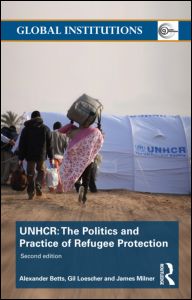 I discovered this series when I went looking for background reading on how the UNHCR functions. I found this book by Loescher et al (pictured), which gave a comprehensive background of the institution in a concise 130 pages (useful for us busy folk). On the inside flap is a list of other volumes that have been assembled, covering institutions from the WHO and the IMF to the International Olympic Committee (see the complete list here). They seem like an imminently practical resource and I've ordered a few more. I may even end up using some in future classes. (FE readers might be interested in the volume on global environmental institutions, which I found in a free online PDF here). The series began in 2005, so some of the volumes might be missing the most recent debates. But for the historical context of these institutions, many of which formed around mid-century (last century), I don't think that should matter much.
I discovered this series when I went looking for background reading on how the UNHCR functions. I found this book by Loescher et al (pictured), which gave a comprehensive background of the institution in a concise 130 pages (useful for us busy folk). On the inside flap is a list of other volumes that have been assembled, covering institutions from the WHO and the IMF to the International Olympic Committee (see the complete list here). They seem like an imminently practical resource and I've ordered a few more. I may even end up using some in future classes. (FE readers might be interested in the volume on global environmental institutions, which I found in a free online PDF here). The series began in 2005, so some of the volumes might be missing the most recent debates. But for the historical context of these institutions, many of which formed around mid-century (last century), I don't think that should matter much.
This is the publisher's summary of the series:
The "Global Institutions Series" is edited by Thomas G. Weiss (The CUNY Graduate Center, New York, USA) and Rorden Wilkinson (University of Manchester, UK) and designed to provide readers with comprehensive, accessible, and informative guides to the history, structure, and activities of key international organizations as well as books that deal with topics of key importance in contemporary global governance. Every volume stands on its own as a thorough and insightful treatment of a particular topic, but the series as a whole contributes to a coherent and complementary portrait of the phenomenon of global institutions at the dawn of the millennium.
Books are written by recognized experts, conform to a similar structure, and cover a range of themes and debates common to the series. These areas of shared concern include the general purpose and rationale for organizations, developments over time, membership, structure, decision-making procedures, and key functions. Moreover, current debates are placed in historical perspective alongside informed analysis and critique. Each book also contains an annotated bibliography and guide to electronic information as well as any annexes appropriate to the subject matter at hand.
Labels:
books,
global environment,
history,
institutions
1.23.2012
spatial-analyst.net
While looking for some remote sensing data last week, I ran into spatial-analyst.net, which I think deserves the FE-website-discovery-of-the-month award. The wiki has pages dedicated to things like "How to download and resample MODIS images". It's geared towards R users, and I'm kind of a Matlab guy, but it's still clearly useful to both parties. For example, I really like their page pointing to various global datasets, some interesting examples of which are here:
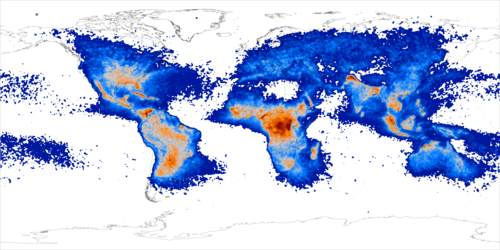 |
| Lighting flash rate |
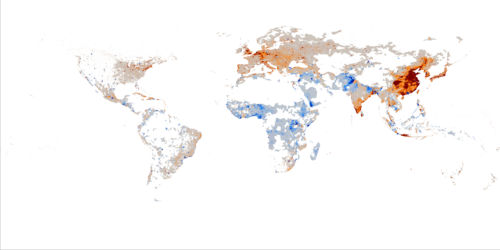 |
| Second principle component of recent population density changes |
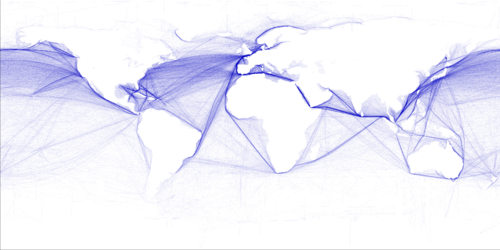 |
| Commercial shipping density |
 |
| Carbon density tones of C / ha. |
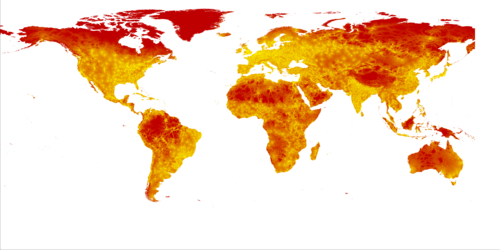 |
| Estimated travel time to major cities (>50k) in hours |
Labels:
data,
data visualization,
global environment,
links
1.05.2012
Global tropical deforestation slowing down
Our colleague Jan Christoph von der Goltz points us to this new working paper by Wheeler, Kraft, and Hammer at the Center for Global Development:
This report summarizes recent trends in large-scale tropical forest clearing identified by FORMA (Forest Monitoring for Action). Our analysis includes 27 countries that accounted for 94 percent of clearing during the period 2000–2005. We highlight countries with relatively large changes since 2005, both declines and increases. FORMA produces indicators that track monthly changes in the number of 1-sq.-km. tropical forest parcels that have experienced clearing with high probability. This report and the accompanying spreadsheet databases provide monthly estimates for 27 countries, 280 primary administrative units, and 2,907 secondary administrative units. Countries’ divergent experiences since 2005 have significantly altered their shares of global clearing in some cases. Brazil’s global share fell by 11.2 percentage points from December 2005 to August 2011, while the combined share of Malaysia, Indonesia, and Myanmar increased by 10.8. The diverse patterns revealed by FORMA’s first global survey caution against facile generalizations about forest clearing in the pantropics. During the past five years, the relative scale and pace of clearing have changed across regions, within regions, and within countries. Although the overall trend seems hopeful, it remains to be seen whether the decline in forest clearing will persist as the global economy recovers.CGD blog link here. While the overall trend is good news, the point about heterogeneity is well taken. See, for example, this time series map of Borneo's forest cover, and in particular the jump between 2000 and 2010:
 |
| Source: UNEP GRID |
Labels:
deforestation,
global environment
12.12.2011
Fukushima's long-term implications
Two articles came out in PNAS Environmental Sciences this week estimating the fallout from the Fukushima nuclear disaster (Yasunari et al. and Kinoshita et al.). Of particular concern is the following from Yasunari et al.:
As a general characteristic, most of the eastern parts of Japan were effected by a total 137 Cs deposition of more than 1,000 MBq km−2 . Our estimates show that the area around NPP in Fukushima, secondarily effected areas (Miyagi and Ibaraki prefectures), and other effected areas (Iwate, Yamagata, Tochigi, and Chiba prefectures) had 137 Cs depositions of more than 100,000, 25,000, and 10,000 MBq km−2 , respectively. Airborne and ground-based survey measurements jointly carried out by MEXT and the US Department of Energy (DOE) (21) show high 137 Cs deposition amounts were observed northwestward and up to a distance of 80 km from Fukushima NPP. It was estimated from the first measurement that by April 29, more than 600,000 MBq km−2 had been deposited in the area, which is greater than our estimate of less than 500,000 MBq km−2 (Fig. 2A), yet well within the range of uncertainty of our method (Fig. S4).1,000 MBq (megabecquerels) per square kilometer is 1 kilobecquerel per square meter, so the three broad exposure estimates correspond to 100, 25, and 10 kBq m-2, with maximum treatments around 500-600 kBq m-2. To answer how worried we should be about this, we turn to Almond, Edlund, and Palme, 2009:
We use prenatal exposure to Chernobyl fallout in Sweden as a natural experiment inducing variation in cognitive ability. Students born in regions of Sweden with higher fallout performed worse in secondary school, in mathematics in particular. Damage is accentuated within families (i.e., siblings comparison) and among children born to parents with low education. In contrast, we detect no corresponding damage to health outcomes. To the extent that parents responded to the cognitive endowment, we infer that parental investments reinforced the initial Chernobyl damage. From a public health perspective, our findings suggest that cognitive ability is compromised at radiation doses currently considered harmless.The heaviest fallout in Sweden (also due to Cesium 137 contamination) was around 65 kBq m-2 (see figure 2 of the paper). Moreover Japan's population density is roughly an order of magnitude larger than Sweden's. Given this, it looks like the long term human costs of this disaster may be absolutely staggering.
Labels:
disasters,
energy,
global environment,
health
7.17.2011
Weekend reading on the global environment
Trophic Downgrading of Planet Earth
Estes et al.
Science 2011
Until recently, large apex consumers were ubiquitous across the globe and had been for millions of years. The loss of these animals may be humankind’s most pervasive influence on nature. Although such losses are widely viewed as an ethical and aesthetic problem, recent research reveals extensive cascading effects of their disappearance in marine, terrestrial, and freshwater ecosystems worldwide. This empirical work supports long-standing theory about the role of top-down forcing in ecosystems but also highlights the unanticipated impacts of trophic cascades on processes as diverse as the dynamics of disease, wildfire, carbon sequestration, invasive species, and biogeochemical cycles. These findings emphasize the urgent need for interdisciplinary research to forecast the effects of trophic downgrading on process, function, and resilience in global ecosystems.
A Large and Persistent Carbon Sink in the World’s Forests
Pan et al.
Science 2011
The terrestrial carbon (C) sink has been large in recent decades, but its size and location remain uncertain. Using forest inventory data and long-term ecosystem C studies, we estimated a total forest sink of 2.4 ± 0.4 Pg C yr–1 globally for 1990–2007. We also estimated a source of 1.3 ± 0.7 Pg C yr–1 from tropical land-use change, consisting of a gross tropical deforestation emission of 2.9 ± 0.5 Pg C yr–1 partially compensated by a C sink in tropical forest regrowth of 1.6 ± 0.5 Pg C yr–1. Together, the fluxes comprise a net global forest sink of 1.1 ± 0.8 Pg C yr–1, with tropical estimates having the largest uncertainties. This forest sink is equivalent in magnitude to the terrestrial sink deduced from fossil fuel emissions and constraints of ocean and atmospheric sinks.
Estes et al.
Science 2011
Until recently, large apex consumers were ubiquitous across the globe and had been for millions of years. The loss of these animals may be humankind’s most pervasive influence on nature. Although such losses are widely viewed as an ethical and aesthetic problem, recent research reveals extensive cascading effects of their disappearance in marine, terrestrial, and freshwater ecosystems worldwide. This empirical work supports long-standing theory about the role of top-down forcing in ecosystems but also highlights the unanticipated impacts of trophic cascades on processes as diverse as the dynamics of disease, wildfire, carbon sequestration, invasive species, and biogeochemical cycles. These findings emphasize the urgent need for interdisciplinary research to forecast the effects of trophic downgrading on process, function, and resilience in global ecosystems.
A Large and Persistent Carbon Sink in the World’s Forests
Pan et al.
Science 2011
The terrestrial carbon (C) sink has been large in recent decades, but its size and location remain uncertain. Using forest inventory data and long-term ecosystem C studies, we estimated a total forest sink of 2.4 ± 0.4 Pg C yr–1 globally for 1990–2007. We also estimated a source of 1.3 ± 0.7 Pg C yr–1 from tropical land-use change, consisting of a gross tropical deforestation emission of 2.9 ± 0.5 Pg C yr–1 partially compensated by a C sink in tropical forest regrowth of 1.6 ± 0.5 Pg C yr–1. Together, the fluxes comprise a net global forest sink of 1.1 ± 0.8 Pg C yr–1, with tropical estimates having the largest uncertainties. This forest sink is equivalent in magnitude to the terrestrial sink deduced from fossil fuel emissions and constraints of ocean and atmospheric sinks.
Labels:
global environment,
Science Magazine
Subscribe to:
Posts (Atom)


